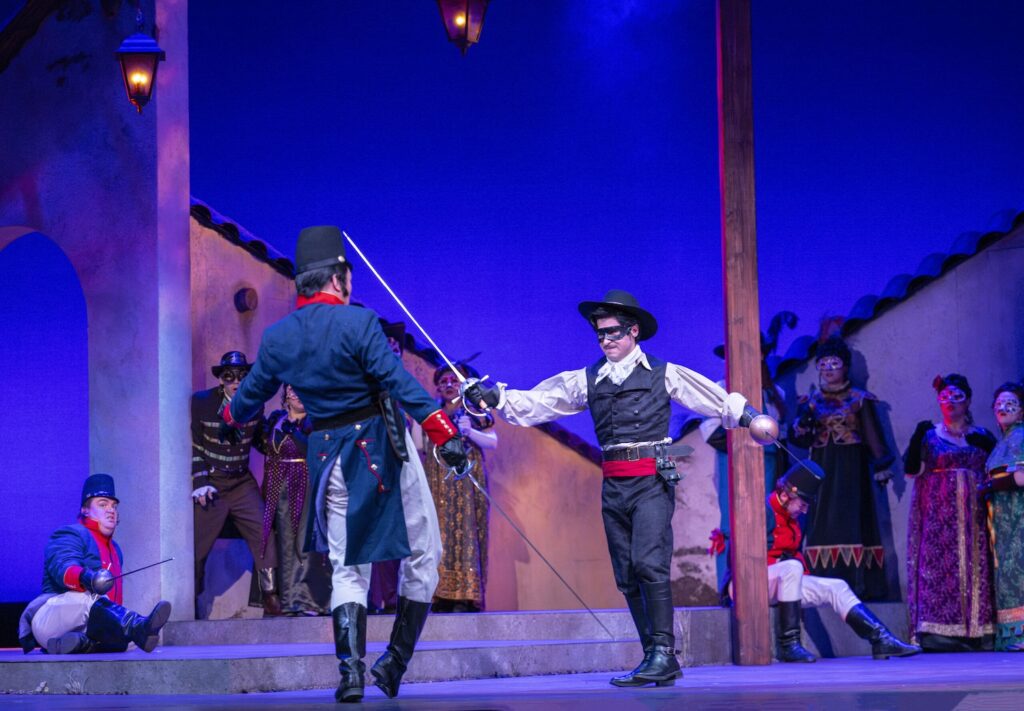It was only a matter of time — first a novella (1917), a pulp magazine series (1919-1954), a few high profile movies (1920, 1940, 1998), a TV series (1957), a West End musical (2008). Now, finally, at last, an opera — its Fort Worth premiere in 2022!
Zorro, the bandito hero, was created by Illinois born Johnston McCulley (1883-1958), an L.A. based author and screenwriter, whose amazingly prolific oeuvre finds many additional serialized heroes, among them Thubway Tham, the Green Ghost, the Crimson Clown and the Spider.
Zorro, surely his richest creation, is based on an historical figure of the early 19th century, and some actual events in Spanish California at the cusp of becoming Mexican California, a story that specifically takes place in La Reina de los Angeles, these days shortened to L.A. — though the opera is yet to be seen there. This Opera San Jose production will travel to Phoenix and Louisville (KY).
The composer/librettist is Hector Armienta, a Mexican-American born in L.A. who explores LatinX subjects (his terminologies). Zorro is the second part of a trilogy to be called Aguas Ancestrales.
It is a numbers opera, sort of like bel canto opera, though without the structural formality. There are ten scenes, from very brief (the sword carving “Z” into Diego’s flesh), to extended (his final sword fight with Zorro’s adversarial military school buddy, the alcade Moncada). The opera is a spectrum of operatic styles, from tragic melodrama to slapstick comedy, and everything in between, à la Monteverdi’s L’incoronazione di Poppea.

Aside from the opera’s love triangle centerpiece it likes to contrast the characters who act with great purpose, good or bad, to the characters who have no purpose in their lives. Every scene quickly achieves the maximum emotional excitement inherent in Signor Armienta’s mariachi esthetic, which it relentlessly exploits, à la zarzuela.
Mr. Armienta, who works in an easy, lush and highly colorful Romantic style, much like Daniel Catán’s Florencia en el Amazonas, supplies his singers with inexhaustible melodies for his texts. It adds definition to bel canto — much beautiful singing simply pours out. The libretto is mostly in English with occasional lapses into a phrase or two of the Spanish we all know. Opera San Jose projects easily readable supertitles in both English and in Spanish for many in its local audience.
The opera is scored for chamber orchestra, mostly single winds and brass, with strings and harp, and of course the necessary percussion instruments when it lapses into quotations of Mexican soul music. There is a scene for flamenco guitar and dancer — sine non qua! The chamber orchestra score renders the opera compatible only to smaller theaters, though it is big singing — Signor Armienta asks for a Verdi baritone to intone his villain, the mayor Moncada.
Diego de la Vega AKA Zorro is a lyric tenor, who sings and sings when not brandishing a sword. Young Chilean born, L.A. tenor Xavier Prado was of indefatigable voice that never lost its sheen, and of the flashy posturing befitting a mythical bandito. Once an OSJ artist-in-residence, he has recently won important competitions as well as participating in Pesaro’s Accademia Rossiniana. Mr. Prado is a singer of proud achievement and great promise.
His nemesis was the Reina de Los Angeles mayor Octavio Rivera y Moncada. Diego and Moncada were great friends at a military academy in Spain, who end the opera in deadly battle with one another — a beautifully staged sword fight (Dave Maier, of San Francisco Opera and the Marin Shakespeare Co, was the fight director). Moncada was sung by Romanian born, German baritone Eugene Brancoveanu. Of requisite big voice he fulfilled his role as the opera’s villain who wished to institute a caste system.
Diego’s old girlfriend Carlotta, whom he meets upon his return from Spain was sung by mezzo soprano Melisa Sonetti Luna. Carlotta is the daughter of Spanish California’s governor (whom we do not meet). She still loves Diego, who once loved her but Diego now knows that he loves his childhood mestiza friend Ana Maria, sung by Maria Brea, daughter of Diego’s nanny Toypurina, sung by Deborah Martinez Rosengaus. All three women, of fine voice and presence, have sung many roles at Opera San Jose.

Special mention must be given to fine coloratura soprano Arianna Rodriguez who shone in her role of Luisa, a servant at Diego’s family estate, and to bass-baritone Jesus Vicente Murillo as Sergeant Gomez who knowingly supplied the necessary buffo in his role as Moncada’s adjunct, and supplied great Papageno-like charm as the intended husband of Luisa. As well Barton Steve Valenzuela beautifully sang the cameo role of Zazueta, the master swordsman who was Diego’s mentor in Spain.
Opera San Jose’s 16 member chorus well managed to impersonate the opera’s indigenous population.
The new production was staged by David Radamés Toro and designed by Liliana Duque-Pińeiro, lighted by Tláloc Loopez-Watermann, with costumes by Ulises Alcala — the same designers as for Opera San Jose’s recent Florencia en el Amazonas. It was a functional production of little inspiration.
Conductor Jorge Parodi brought high polish to Hector Armienta’s score, both vocally and orchestrally, making the evening musically quite charming.
Michael Milenski
California Theater, San Jose, CA, April 19, 2025
All photos copyright David Allen, courtesy of Opera San Jose.